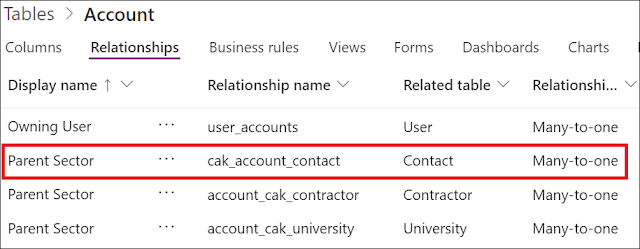DYNAMICS 365 HOW TO CREATE AND MANAGE POLYMORPHIC LOOKUP ATTRIBUTE IN WEBAPI
Previously, we saw
how to create a Polymorphic Lookup Attribute using the Polymorphic Lookup Manager plugin
and
how to create a Polymorphic Lookup Attribute using SDK
In this post, we will see how to create a Polymorphic Lookup Attribute using WebAPI.
We will see as well, what are the different actions that can be done against a polymorphic lookup attribute using this method.
- In order to apply these actions, I will be using Postman to call the needed APIs requests
- First, you have to create an App Registration in Azure and enable its options as explained in this post to be able to connect to Dynamics 365 environment through Postman using the OAUTH authentication
-
After connecting to Dynamics 365 environment in Postman, you have to send a POST request to create the
Polymorphic Lookup Attribute with its relationships.
In this exemple, I will create the Polymorphic Lookup Attribute with four relationships under the account table- Method: POST
- API request URL: https://<ORGURL>/api/data/v9.2/CreatePolymorphicLookupAttribute
-
Request body:
{
"OneToManyRelationships": [
{
"SchemaName": "account_cak_contractor",
"ReferencingEntity": "account",
"ReferencedEntity": "cak_contractor"
},
{
"SchemaName": "account_cak_education",
"ReferencingEntity": "account",
"ReferencedEntity": "cak_education"
},
{
"SchemaName": "account_cak_health",
"ReferencingEntity": "account",
"ReferencedEntity": "cak_health"
},
{
"SchemaName": "account_cak_university",
"ReferencingEntity": "account",
"ReferencedEntity": "cak_university"
}
],
"Lookup": {
"AttributeType": "Lookup",
"AttributeTypeName": {
"Value": "LookupType"
},
"Description": {
"@odata.type": "Microsoft.Dynamics.CRM.Label",
"LocalizedLabels": [
{
"@odata.type": "Microsoft.Dynamics.CRM.LocalizedLabel",
"Label": "Parent Sector",
"LanguageCode": 1033
}
],
"UserLocalizedLabel": {
"@odata.type": "Microsoft.Dynamics.CRM.LocalizedLabel",
"Label": "Parent Sector",
"LanguageCode": 1033
}
},
"DisplayName": {
"@odata.type": "Microsoft.Dynamics.CRM.Label",
"LocalizedLabels": [
{
"@odata.type": "Microsoft.Dynamics.CRM.LocalizedLabel",
"Label": "Parent Sector",
"LanguageCode": 1033
}
],
"UserLocalizedLabel": {
"@odata.type": "Microsoft.Dynamics.CRM.LocalizedLabel",
"Label": "Parent Sector",
"LanguageCode": 1033
}
},
"SchemaName": "cak_ParentSectorId",
"@odata.type": "Microsoft.Dynamics.CRM.ComplexLookupAttributeMetadata"
}
} - Reponse: N:1 Relationship Guids and Polymorphic Lookup Attribute Guid
-
Once the Polymorphic Lookup Attribute is created, you can achieve the following actions against it using WebAPI
-
Add new relationship to an existing Polymorphic Lookup Attribute
- Method: POST
- API request URL: https://<ORGURL>/api/data/v9.2/RelationshipDefinitions
-
Request body:
{
"SchemaName": "cak_account_contact",
"@odata.type": "Microsoft.Dynamics.CRM.OneToManyRelationshipMetadata",
"ReferencedEntity": "contact",
"ReferencingEntity": "account",
"Lookup": {
"AttributeType": "Lookup",
"AttributeTypeName": {
"Value": "LookupType"
},
"Description": {
"@odata.type": "Microsoft.Dynamics.CRM.Label",
"LocalizedLabels": [
{
"@odata.type": "Microsoft.Dynamics.CRM.LocalizedLabel",
"Label": "Parent Sector",
"LanguageCode": 1033
}
],
"UserLocalizedLabel": {
"@odata.type": "Microsoft.Dynamics.CRM.LocalizedLabel",
"Label": "Parent Sector",
"LanguageCode": 1033
}
},
"DisplayName": {
"@odata.type": "Microsoft.Dynamics.CRM.Label",
"LocalizedLabels": [
{
"@odata.type": "Microsoft.Dynamics.CRM.LocalizedLabel",
"Label": "Parent Sector",
"LanguageCode": 1033
}
],
"UserLocalizedLabel": {
"@odata.type": "Microsoft.Dynamics.CRM.LocalizedLabel",
"Label": "Parent Sector",
"LanguageCode": 1033
}
},
"SchemaName": "cak_ParentSectorId",
"@odata.type": "Microsoft.Dynamics.CRM.LookupAttributeMetadata"
}
} - Reponse: No content response with 204 Status that indicates the success of the request
-
Delete a relationship from an existing Polymorphic Lookup Attribute
- Method: DELETE
- API request URL: https://<ORGURL>/api/data/v9.2/RelationshipDefinitions(<RELATIONSHIPGUID>)
- Request body: Empty body
- Reponse: No content response with 204 Status that indicates the success of the request
-
Delete an existing Polymorphic Lookup Attribute
- Method: DELETE
- API request URL: https://<ORGURL>/api/data/v9.2/EntityDefinitions(<ENTITYGUID>)/Attributes(<ATTRIBUTEGUID>)
- Request body: Empty body
- Reponse: No content response with 204 Status that indicates the success of the request
-
Add new relationship to an existing Polymorphic Lookup Attribute
Hope This Helps!









Comments
Post a Comment